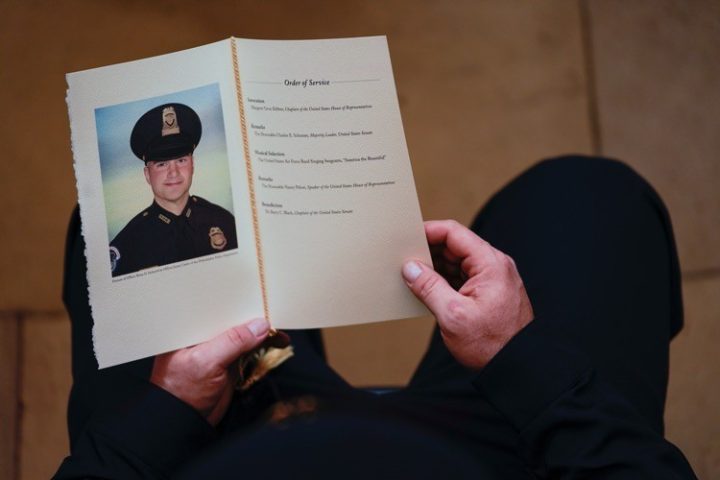
In confirming that Capitol Hill Officer Brian Sicknick died of natural causes, the medical examiner for Washington, D.C., did more than upend the false narrative that unruly protesters at the U.S. Capitol on January 6 “killed” the cop.
He also proved that House impeachment managers perpetrated a major falsehood to claim that President Trump should be impeached.
The medical examiner, Francisco J. Diaz, told the Washington Post on Monday that Sicknick died of two strokes that had nothing to do with his trying to control unruly protesters who stormed the U.S. Capitol Hill on January 6.
Diaz’s conclusions mean House impeachment managers should not have relied on the New York Times’s false report that Sicknick died because a protester struck him with a fire extinguisher. News that a stroke felled the 42-year-old Trump voter was published the same day as the false report in the Times.
That should have put the brakes on myriad claims that pro-Trump protesters “killed” Sicknick. But the truth isn’t what the hate-Trump media and Democrats were after. They wanted Trump’s scalp and were determined to get it.
Final Report
Diaz, the Post reported, “said the autopsy found no evidence the 42-year-old officer suffered an allergic reaction to chemical irritants, which Diaz said would have caused Sicknick’s throat to quickly seize. Diaz also said there was no evidence of internal or external injuries.”
But beyond that, Sicknick suffered an arterial blood clot, the coroner said:
Diaz said Sicknick suffered two strokes at the base of the brain stem caused by a clot in an artery that supplies blood to that area of the body. Diaz said he could not comment on whether Sicknick had a preexisting medical condition, citing privacy laws.
In the days after the riot, police and a Justice Department official attributed Sicknick’s death to his efforts to contain the riot.
Democratic House managers arguing for then-President Donald Trump’s impeachment said Sicknick was killed by rioters, citing a New York Times story that said police initially believed Sicknick had been struck with a fire extinguisher. The Times later updated the story saying there was no evidence of blunt-force trauma.
A prosecutor told the Post that the finding will hamper efforts to connect the unruly mob to Sicknick’s death. It appears, after all, that he might have been ill.
Times, Impeachment Managers Should Have Known
But the import of the coroner’s report goes beyond merely proving that no one “killed” Sicknick, which is what the Times falsely reported in at least two stories.
One was headlined “He Dreamed of Being a Police Officer, Then Was Killed by a Pro-Trump Mob,” a lurid account similar to the fake news that appeared under this headline: “A Capitol Police officer dies from injuries sustained during the pro-Trump rampage.”
Both stories are dated January 8, the same day that lefitst ProPublica reported that Sicknick died of a stroke. That news came from his brother.
The night of the riot, Sicknick texted his brother, Ken, to say he was pepper-sprayed twice but otherwise OK.
“But the day after that text exchange, the family got word that Brian Sicknick had a blood clot and had had a stroke; a ventilator was keeping him alive,” ProPublica reported.
“We weren’t expecting it,” Ken Sicknick told the website.
Despite that, ProPublica’s story contradicted itself. It falsely claimed Sicknick was “slain” and “died of injuries sustained while trying to protect the Capitol.”
And the Times did not correct its falsehoods until February 15.
Even worse, however, was one result of the false narrative. It wound up in the impeachment brief that indicted Trump and indirectly blamed him for Sicknick’s death.
“The insurrectionists killed a Capitol Police officer by striking him in the head with a fire extinguisher,” the memorandum says. Footnote 131 attributed that falsehood to the Times.
House Memo Page 28On February 2, the date of the House memorandum, CNN reported that authorities couldn’t identify the moment Sicknick suffered “fatal injuries.”
That’s because Sicknick, as D.C.’s coroner said and ProPublica reported two days after the mostly peaceful protest, didn’t suffer fatal injuries. Indeed, as the coroner reported, the autopsy turned up no evidence of any external injuries.



